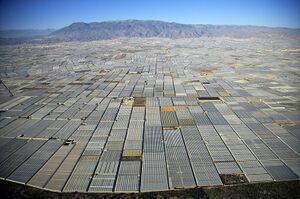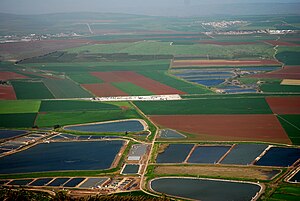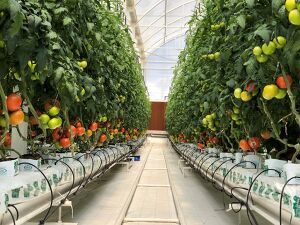Agriculture in Khyragus
This article is incomplete because it is pending further input from participants, or it is a work-in-progress by one author. Please comment on this article's talk page to share your input, comments and questions. Note: To contribute to this article, you may need to seek help from the author(s) of this page. |

Agriculture in Khyragus is a major and highly developed industry accounting for approximately 3% of the total GDP. Much of Khyragus is well suited for agricultural use. Khyragus is a net exporter of food and a leading developer of agricultural technology. The primary crops cultivated are rice, sugarcane, potatoes, and algae, however, Khyragus exports large quantities of tropical fruits, coffee. and tobacco.
History
Before 1750
The oldest known archeological evidence of agricultural activities dates to approximately 6000 BCE. More advanced agricultural activities became widespread around the year 4000 BCE with the development of the Yandrea civilization. Primarily agricultural was concentrated around the Ikeyrbe River Valley, where a steady fresh water supply and nutrient-rich soil provided an ideal location for farming. Chinampas was the predominant agricultural technique, and were used to grow maize, squash, beans, and rice.
Around 3000 BCE, the Ukzeande Empire created an extensive network of canals to provide irrigation and flood control.
Modern Era
Khyragusian Technate
Post Technocratic Khyragus
Farm Types
Much of Khyragus's agricultural output is produced by farma zaednica, or community farm settlements. etc. etc. privatization etc.
Farma Zaednica
- Need to fix some of this**
Farma zaednicas are collective communities based on agriculture. The first of these communities, Novo Orkani, was established in 1938. Under the farma zaednica system, communal plots are farmed, and the resulting profit from harvest is given to workers as a dividend. This system would eventually become the basis for other industries as well.
Urbana Gradina
Urban farms
Production
| Millions of Tonnes in | 2020 |
|---|---|
| Rice | 65.2 |
| Sugar cane | 47.8 |
| Potatoes | 32.5 |
| Microalgae | 24.1 |
| Maize | 15.3 |
| Citrus | 11.8 |
| Fruit (other) | 9.6 |
| Bananas | 4.1 |
| Vegetables (combined) | 3.3 |
| Oats | 3.1 |
| Chicken meat | 2.9 |
| Hen eggs | 1.4 |
| Quinoa | 0.8 |
| Legumes | 0.6 |
Major Agricultural Products
Food Crops

The primary grain crops cultivated in Khyragus are rice and maize which constitute Khyragus's main staple crops. Rice is generally grown in wetlands along the western side of the Okofil Mountains, where heavy rainfall and steady river flow provide plentiful water supplies. Golden rice and Basmati are the primary rice cultivars produced, however, several other varieties are grown. Maize is grown in the more arid plains region in the northeast of Khyragus. Maize is used for human consumption, as animal feed, and for the production of ethanol-based biofuels. Oats and quinoa are also grown in large quantities, along with wheat and barley.
About 12% of cultivated land is used to produce legumes. Peanuts are the largest legume crop by output and are an important source of food. Other legumes, such as lentils and black beans are grown throughout Khyragus.
Potatoes, tomatoes, cabbage, and onions are Khyragus's principal vegetable crops. The majority of these crops are grown intensively in hydroponic facilities in the western islands. Potatoes are grown in nearly every region of Khyragus, but the southeastern area produces the majority of potatoes produced.
Khyragus has historically been a major producer and exporter for a variety of fruits to other nations in Astyria. Bananas, along with various citrus fruits such as: Mandarin oranges, lemons, and limes are the most produced fruits. Citrus is mainly cultivated in irrigated groves along the western coasts of Khyragus and the southern regions. Khyragus has also established an international reputation for being a large supplier other tropical fruits, such as zelbolko, lychees, mangos and cacti fruit.
Cash Crops
Cash crops have historically been an important part of Khyragusian agriculture. Sugar cane is the leading cash crop, although production declined heavily in the 1920s, it began to increase steadily during the 1960s through to the present day. Sugar cane is cultivated along the western coasts and islands, where the tropical climate provides favorable conditions for cultivation. In addition to being used in the production of sugar it also used to produce ethanol.
Coffee, tobacco, tea, and cotton are also significant cash crops. Cigars are a famous Khyragusian product and are heavily exported internationally. Cannabis is another key cash crop produced in Khyragus. Although the majority of cannabis grown is done by individuals for personal use, commercial farms that supply pharmaceutical companies are widespread. Khyragus is known to be an origin point for black market and grey market cannabis exported to other countries, especially Slovertia.
Livestock
Fishing and Aquaculture
Algaculture
Khyragusian microalgae production totaled 24.1 million tonnes in 2020. Algae is Khyragus's most important industrial crop, being used to produce biofuels and bioplastics. Over 20.5 million barrels of algae biofuels were produced in 2018. Algae is also used in animal feed, due to it's high protein and nutrient levels. A small amount of the algae is also used for human consumption.
Most of Khyragus's algae is produced using wastewater from sewage or agricultural runoff. These facilities first process the water using anaerobic digestion which produces methane, carbon dioxide, and organic fertilizer. The methane is used to create synthetic natural gas. The fertilizer and treated water is then used to cultivate algae, producing clean water and algae biomass. After oil is extracted the remaining biomass is typically used to create ethanol-based biofuels.
Algae oil is also used to create bioplastics. The Khyragusian government taxes petroleum-based plastics and non-biodegradable plastics at a higher rate than alternatives in an attempt to reduce pollution and fossil fuel dependency. Bioplastic production is Khyragus increasing. In 2020, bioplastic production from algae accounted for 10.3% of all domestic plastic production.


